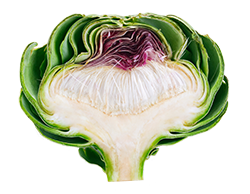- Home
- PRESERVES
- ARTICHOKE
The artichoke: learn to appreciate it
The Cynara scolymus is better known as the artichoke and no one is surprised if you say that the plant is a member of the thistle family. The artichoke comes from Sicily, the Sicilians say. The Italians of the mainland claim that it ended up in Firenze through Napoli in 1466.An artichoke has its own taste and it might turn out to be an acquired taste. Topinambour (Jerusalem artichoke) comes close as does the 'fiddly' Chinese artichoke (in French crosne du Japon), both not related, by the way.
The artichoke coarse flower can grow quite large and is loved for its fleshy character. If the head is still immature and small, it is edible in its entirety. Later on there are fibrous leaves and only the fleshy base of the flowers are edible. No front teeth or patience? Then forget it. You eat by picking the leaves one by one from the boiled head, and yes, according to the etiquette that is allowed with your fingers. Then you dip them into melted butter or a vinaigrette (delicious with mashed egg). Only the base of the leaf can then be nibbled or sucked with one’s front teeth. Très chic! Finally, the 'heart' reveals itself (under the 'hay' (also called the 'beard') and is considered to be the best part.
It is mainly the Italians and the Spanish who consume a lot of artichokes. Hence our mainly Italian preserves with only the best parts of this curious flower.




